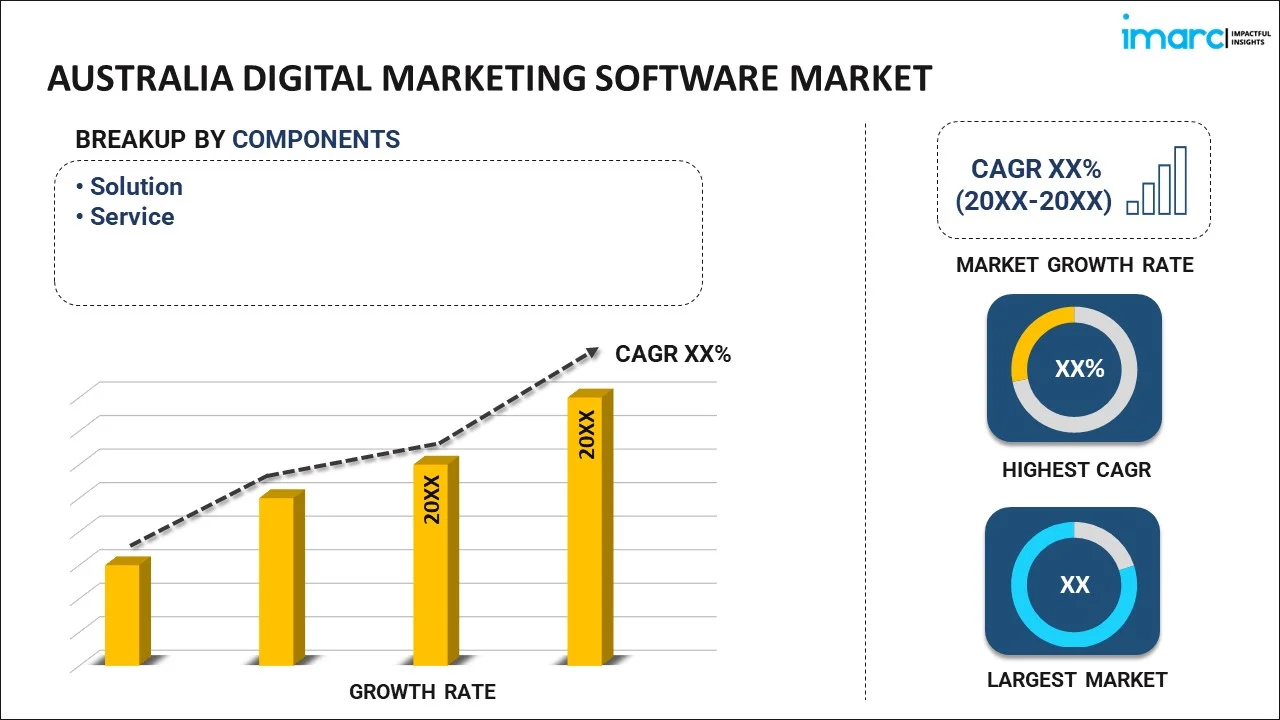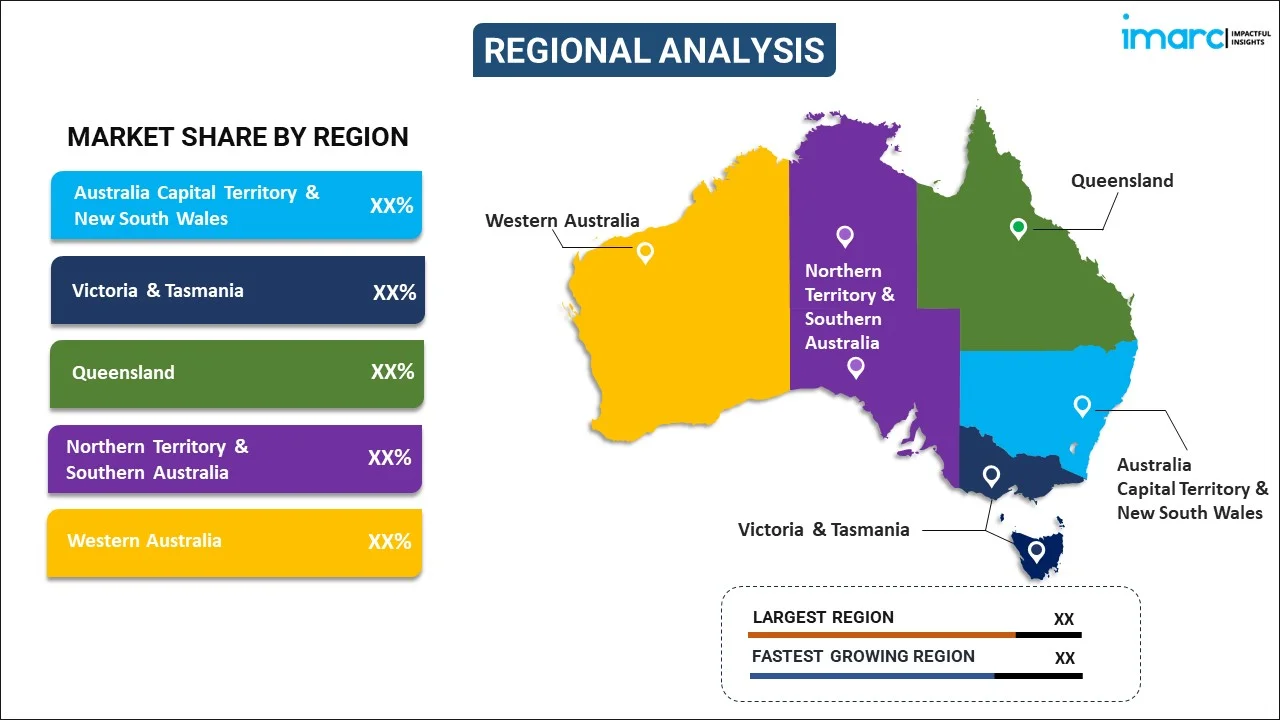
Australia Digital Marketing Software Market Report by Component (Solution, Service), Deployment Type (On-premises, Cloud-based), Organization Size (Large Enterprises, Small and Medium Enterprises (SMEs)), End Use (Media and Entertainment, Manufacturing, Retail, BFSI, Information Technology, Healthcare, and Others), and Region 2024-2032
Australia Digital Marketing Software Market Overview:
The Australia digital marketing software market is projected to exhibit a growth rate (CAGR) of 11.20% during 2024-2032. The market is driven by the growing reliance on the internet to collect information about customer trends, interests, and behavior, along with the rising need for constant and successful engagement of clients among organizations.
|
Report Attribute
|
Key Statistics
|
|---|---|
|
Base Year
|
2023 |
|
Forecast Years
|
2024-2032
|
|
Historical Years
|
2018-2023
|
| Market Growth Rate (2024-2032) | 11.20% |
Australia Digital Marketing Software Market Trends:
Growing Reliance on Internet
Businesses are relying on digital marketing platforms to reach clients, since more Australians are spending substantial time online. As a result, more money is being spent on digital marketing tools to reach and interact with these internet users. An abundance of information about customer trends, interests, and behavior can be found on the internet. By using this data, digital marketing software builds comprehensive customer profiles and insights that help companies generate more individualized and targeted marketing efforts. In many cases, digital marketing is less expensive than traditional marketing avenues. Businesses can precisely connect their target audience thanks to the internet, which lowers wasted advertising costs and boosts return on investment (ROI). It is this cost-effectiveness that propels the use of digital marketing tools. Real-time communication between customers and companies is made possible via the internet. Digital marketing software tools improve customer happiness and engagement by enabling quick responses to customer concerns, real-time campaign modifications, and fast feedback collection.
The need for digital marketing techniques to draw in, convert, and keep online buyers is growing because of the surge in online purchasing. Digital marketing software is a vital tool for e-commerce companies looking to maximize their marketing across multiple internet platforms. Digital marketing software is utilized by businesses to oversee social media campaigns, evaluate engagement metrics, and enhance brand visibility and loyalty. Because a large percentage of buyer decisions about what to buy begin with an internet search, companies spend money on SEO tactics to increase their online presence. According to the data published on the website of the World Metrics, it is projected that 76% of Australian mobile connections will be made on 4G and 21% on 5G by 2025.
Rising Number of Online Shoppers
As per an article published on the website of the Australia Post in 2024, 8 in 10 Australian households shopped online in 2023. Organizations are developing highly focused marketing programs to draw in the growing number of internet shoppers. Marketing campaigns are more successful when they use digital marketing software, which allows for exact targeting based on buyer behavior, preferences, and demographics. With the use of digital marketing tools, companies can better understand their clientele and increase their satisfaction by providing tailored content, product recommendations, and promotions. There are several ways to interact with clients in the digital sphere, including social media, email, and search engines. Through the management and optimization of these interactions, digital marketing software helps organizations ensure constant and successful engagement throughout the customer journey.
Tools for analyzing and improving the online buying experience, ranging from landing pages to checkout procedures, are available with digital marketing software. Companies can improve conversion rates and boost sales by locating and resolving pain points in the client journey. As more people are shopping online, manual marketing efforts are becoming unfeasible. With the use of automation features like social media scheduling, dynamic ad placements, and automated email campaigns, digital marketing software enables firms to effectively oversee extensive marketing initiatives.
Australia Digital Marketing Software Market News:
- February 2024: News Corp Australia signed a new multi-year agreement with technology platform Outbrain to leverage Outbrain’s Smartlogic, an AI-powered recommendation technology, for improving the online content discovery experience and how audiences are exploring and consuming media across their digital platforms.
- September 2023: Lounge Lizard Worldwide Inc., an industry leader in branding, web design, and digital marketing, announced its strategic expansion to Richmond, Virginia, as part of its commitment to offer more localized and tailored services to clients.
Australia Digital Marketing Software Market Segmentation:
IMARC Group provides an analysis of the key trends in each segment of the market, along with forecasts at the country level for 2024-2032. Our report has categorized the market based on component, deployment type, organization size, and end use.
Component Insights:

- Solution
- Customer Relationship Management (CRM)
- Email Marketing
- Social Media
- Search Marketing
- Content Management
- Marketing Automation
- Campaign Management
- Others
- Service
- Professional Services
- Managed Services
The report has provided a detailed breakup and analysis of the market based on the component. This includes solution (customer relationship management (CRM), email marketing, social media, search marketing, content management, marketing automation, campaign management, and others) and service (professional services and managed services).
Deployment Type Insights:
- On-premises
- Cloud-based
The report has provided a detailed breakup and analysis of the market based on the deployment type. This includes on-premises and cloud-based.
Organization Size Insights:
- Large Enterprises
- Small and Medium Enterprises (SMEs)
A detailed breakup and analysis of the market based on the organization size have also been provided in the report. This includes large enterprises and small and medium enterprises (SMEs).
End Use Insights:
- Media and Entertainment
- Manufacturing
- Retail
- BFSI
- Information Technology
- Healthcare
- Others
The report has provided a detailed breakup and analysis of the market based on the end use. This includes media and entertainment, manufacturing, retail, BFSI, information technology, healthcare, and others.
Regional Insights:

- Australia Capital Territory & New South Wales
- Victoria & Tasmania
- Queensland
- Northern Territory & Southern Australia
- Western Australia
The report has also provided a comprehensive analysis of all the major regional markets, which include Australia Capital Territory & New South Wales, Victoria & Tasmania, Queensland, Northern Territory & Southern Australia, and Western Australia.
Competitive Landscape:
The market research report has also provided a comprehensive analysis of the competitive landscape. Competitive analysis such as market structure, key player positioning, top winning strategies, competitive dashboard, and company evaluation quadrant has been covered in the report. Also, detailed profiles of all major companies have been provided.
Australia Digital Marketing Software Market Report Coverage:
| Report Features | Details |
|---|---|
| Base Year of the Analysis | 2023 |
| Historical Period | 2018-2023 |
| Forecast Period | 2024-2032 |
| Units | US$ Billion |
| Scope of the Report | Exploration of Historical Trends and Market Outlook, Industry Catalysts and Challenges, Segment-Wise Historical and Future Market Assessment:
|
| Components Covered |
|
| Deployment Types Covered | On-premises, Cloud-based |
| Organization Sizes Covered | Large Enterprises, Small and Medium Enterprises (SMEs) |
| End Uses Covered | Media and Entertainment, Manufacturing, Retail, BFSI, Information Technology, Healthcare, Others |
| Regions Covered | Australia Capital Territory & New South Wales, Victoria & Tasmania, Queensland, Northern Territory & Southern Australia, Western Australia |
| Customization Scope | 10% Free Customization |
| Post-Sale Analyst Support | 10-12 Weeks |
| Delivery Format | PDF and Excel through Email (We can also provide the editable version of the report in PPT/Word format on special request) |
Key Questions Answered in This Report:
- How has the Australia digital marketing software market performed so far and how will it perform in the coming years?
- What has been the impact of COVID-19 on the Australia digital marketing software market?
- What is the breakup of the Australia digital marketing software market on the basis of component?
- What is the breakup of the Australia digital marketing software market on the basis of deployment type?
- What is the breakup of the Australia digital marketing software market on the basis of organization size?
- What is the breakup of the Australia digital marketing software market on the basis of end use?
- What are the various stages in the value chain of the Australia digital marketing software market?
- What are the key driving factors and challenges in the Australia digital marketing software?
- What is the structure of the Australia digital marketing software market and who are the key players?
- What is the degree of competition in the Australia digital marketing software market?
Key Benefits for Stakeholders:
- IMARC’s industry report offers a comprehensive quantitative analysis of various market segments, historical and current market trends, market forecasts, and dynamics of the Australia digital marketing software market from 2018-2032.
- The research report provides the latest information on the market drivers, challenges, and opportunities in the Australia digital marketing software market.
- Porter's five forces analysis assist stakeholders in assessing the impact of new entrants, competitive rivalry, supplier power, buyer power, and the threat of substitution. It helps stakeholders to analyze the level of competition within the Australia digital marketing software industry and its attractiveness.
- Competitive landscape allows stakeholders to understand their competitive environment and provides an insight into the current positions of key players in the market.
Need more help?
- Speak to our experienced analysts for insights on the current market scenarios.
- Include additional segments and countries to customize the report as per your requirement.
- Gain an unparalleled competitive advantage in your domain by understanding how to utilize the report and positively impacting your operations and revenue.
- For further assistance, please connect with our analysts.
 Inquire Before Buying
Inquire Before Buying
 Speak to an Analyst
Speak to an Analyst
 Request Brochure
Request Brochure
 Request Customization
Request Customization




.webp)




.webp)












